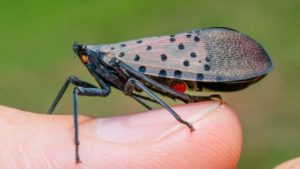
How can you find spotted lanternflies? Look for these signs and remember tips for removal.
The spotted lanternfly nymphs undergo four stages as they mature toward adulthood. During the first three stages, the insect is black with white spots. During the fourth and final stage before adulthood, the nymph becomes bright red, covered in black stripes and white spots. This is the stage they are in from July to September, and chances are you’ve already started seeing these bright red bugs outside. But what do you do when you see spotted lanternflies on your property, sidewalk, or car? While spotted lanternflies don’t harm animals or humans, they can reduce the quality of life for people in heavily infested areas and harm plants, according to Maryland’s agriculture department that has recommended a few tips for what you can do to reduce the spread of the invasive sap-feeding pests.
What Do Spotted Lanternflies Do to Plants?
Spotted lanternflies damage host plants in two ways. First, adults leave eggs on a host plant, and when those nymphs emerge, they insert their beaks into leaves and stems to feed on the sap. This removes valuable nutrients from the plant. Additionally, during feeding, the insects produce large amounts of waste called “honeydew” because of its rich sugar content. Their honeydew acts as a base for the growth of a sooty mold that impairs photosynthesis and disfigures leaves and fruit. Honeydew also attracts stinging insects like bees and wasps. The sooty mold often becomes so thick that it inhibits the plant from photosynthesizing.
How to Spot Adult Lanternflies
You can detect spotted lanternflies by their notable characteristics. These include:
- The adult forewing is gray with black spots of different sizes, and the wing tips have black spots lined in gray
- The adult hindwings have patches of red and black with a white band
- The adult legs and head are black while the abdomen is yellow with black bands
- When adults fly, they prefer to hop/jump and glide, exposing their hindwings
- The hindwings get exposed when they’re frightened or treated with insecticide
The nymphs appear in the fourth stage from July through September. They are about a half-inch long and bright red, with black stripes and white spots. These insects are good jumpers and often hop away to avoid danger.
How to Keep Spotted Lanternflies Away
The spotted lanternfly is a “hitchhiker,” so it can travel easily when nobody’s looking. If you’re in a zone for spotted lanternflies, do the following:
- Check your vehicle: Inspect vehicles for insects or eggs before leaving a location. Check the doors, bumpers, wheel wells, and roofs. Destroy any eggs or insects you find.
- Inspect items being moved: Shipping containers, propane tanks, pallets, and other items stored outdoors before being moved offsite should be inspected for egg masses and insects.
- Park with the windows closed, and if possible, park at least 15 feet away from trees so your car is less likely to be visited by lanternflies.
- Remove and destroy pests: You can crush nymphs and adult insects and scrape egg masses into a plastic bag and put them in the trash.
- Remove Ailanthus (Tree of Heaven) trees, the Spotted Lanternfly’s preferred host from your landscape.
The Maryland Department of Agriculture has more information on quarantine zones and reporting insect sightings. You may also contact your local lawn and landscape health care service team at Scientific Plant Service for guidance and advice regarding these pests and how they may impact your trees.
Scientific Plant Service Is Your Go-To Source In Landscape Healthcare
Scientific Plant Service, located in Baltimore, is a privately owned corporation, chartered in Maryland in 1957 by Frank J. Burke. We started as a full-service Arborists specializing in the care of shade trees and ornamental shrubs, but today we are a Lawn Care company that is a huge part of the community. From aquatic environments and snow management to deer and mole control, SPS has services tailored specifically for your lawn and landscape.
We offer services in Maryland, Washington, DC, and Virginia, including: Harford, Baltimore, Carroll, Frederick, Howard, Anne Arundel, Montgomery, Prince Georges, Talbot, Queen Anne’s, Calvert counties in MD, as well as Loudoun County, Fairfax County, Arlington, Alexandria, and Falls Church in VA. For more information, contact us online, or call us at 410-321-0970. Be sure to follow us on Facebook, Twitter, LinkedIn, Instagram, and Pinterest.

